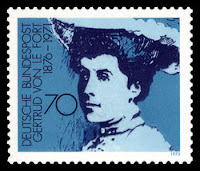As I
have said in past Blogs, every generation in a monastery is exposed to great
writers who influence our journey towards the Lord. One, who is having a revival of sorts, is GERTRUD VON LE FORT.
 |
She was born in the city of Minden , in the former Province of Westphalia , then the Kingdom of Prussia
She and her siblings, Elisabeth and Stephan, grew up in a
very secure and loving family . She
was educated in Hildesheim , and went on to study
at universities in Heidelberg, Marburg and Berlin Bavaria
Despite
publishing some minor works previously, Gertrud's writing career really began
with the publication in 1925 of the posthumous work Glaubenslehre by her mentor, Ernst Troeltsch,
a major scholar in the field of the philosophy of religion, which she had edited.
She converted to Roman
Catholicism the
following year. Most of her writings came after this conversion, and they were
marked by the issue of the struggle between faith and conscience.
Another turning point in Gertrud von le Fort's
life was the end of the World War I which meant a great disaster for the
defeated Germany
In 1931 she
published the novella, de:Die Letzte am Schafott (The Last One at the Scaffold),
based on the 1794 execution of the Carmelite Martyrs of Compiègne who were guillotined during the French Revolution’s
Reign of Terror. The English translation, entitled The Song at the Scaffold,
appeared in 1933, and is still considered as her greatest work. This work was the inspiration for the
opera Dialogues of the Carmelites written by Francis
Poulenc, which premiered in 1957. The opera was based on a similarly
entitled libretto by Georges
Bernanos.
Gertrud went
on to publish over 20 books, comprising poems, novels and short stories.
Her work gained her the accolade of being "the greatest contemporary
transcendent poet". Her works are appreciated for their depth and beauty
of their ideas, and for her sophisticated refinement of style.
She became friends with the theologian and philosopher Romano Guardini (see Blog 8/2/16). In 1920's he was active at Rothenfels/Main castle that was a centre of the Catholic youth movement. As early as 1921 Gertrud read Guardini's The Spirit of the Liturgy and in the following years helped to bring it to awareness of the general public. Father Guardini did the same when Gertrud published her book of poetry Hymns to the Church (another masterpiece in my opinion) in 1924. It was read in the Catholic youth movement and gained popularity there.
She was
nominated by Hermann Hesse for the Nobel Prize in Literature, and was granted
an honorary Doctorate of Theology for her contributions to the issue of
faith in her works.
 |
In 1952, she
won the Gottfried-Keller Prize, an esteemed Swiss literary
award.
 |
| German Stamp- 1975 |
Among her
many other works, were The Eternal Woman (my favorite) in
1934, which appeared in paperback in English in 2010. In this work, she
countered the modernist distortions of the feminine, a meditation on what it
means to be a woman.
 Last year, Ignatius Press brought out a collection of
three of her novellas,The Wife of Pilate and Other Stories, thus introducing her to a new generation of readers.
Last year, Ignatius Press brought out a collection of
three of her novellas,The Wife of Pilate and Other Stories, thus introducing her to a new generation of readers.
In 1939 Gertrud made her home in the town of Oberstdorf in the Bavarian Alps,
and it was there that she died on the
feast of All Saints, 1 November 1971, aged 95.




No comments:
Post a Comment